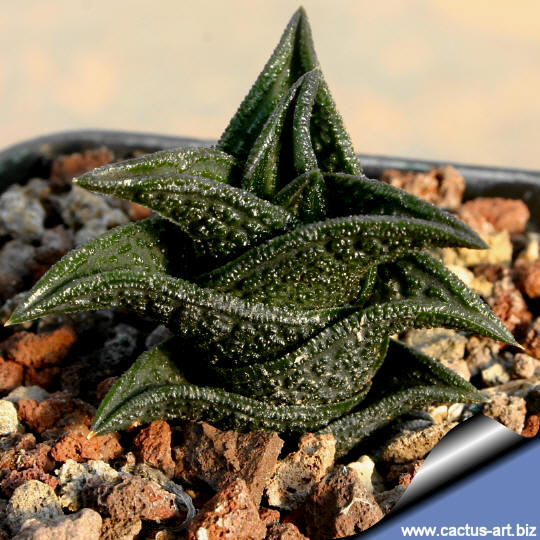|
|
|
Family: Asphodelaceae
(Aloacee - Asphodelaceae, Liliaceae)
Scientific name: Haworthia
nigra (Haw.) Baker
Origin: Haworthia nigra comes
predominantly from the Karoo desesert in the Eastern Cape of South
Africa (from near East London in the South East to north Loeriesfontein
in the North West) particularly those areas north and east of the
related H. viscosa.
Habitat: Grows very well hidden
under bushes or sometime in full sun among stones together with H.
decipiens and G. brachyphylla.
Synonyms:
- Haworthia nigra var. nigra
(von Poelln.) J. Pilbeam
- Haworthia venosa ssp. nigra,
- Haworthia nigra var. schmidtiana
- Haworthia schmidtiana var.
suberecta
- Haworthia schmidtiana var.
pusilla
- Haworthia schmidtiana var.
elongata
- Haworthia schmidtiana var.
angustata
- Haworthia schmidtiana
- Haworthia ryneveldii
- Haworthia nigra var. suberecta
- Haworthia nigra var. pusilla
- Haworthia nigra var. elongata
- Haworthia nigra var. angustata
- Haworthia viscosa ssp. nigra
- Apicra nigra
- Aloe nigra
|
|
Description: It is a slowly
proliferous or stoloniferous species that form caulescent rosettes up to
6 cm in diameter and 10 cm tall (But usually shorter). Typically it make
columns of three-ranked, rather triangular shaped, solid-colored almost
black leaves, but plants are quiet variable depending on clone and
origin. Some of its forms can be almost unbelievably slow growing,
producing no more than one or two leaves a year, and remaining content
in a 6 cm pot for decades.
Stem: Variable from very long elongated or reduced to almost
stemless.
Leaves: Usually in 3-tiered (or sometime in spiral) arrangement ,
often displaying a densely tuberculate, heavily sculpted surface, marked
with dark lines and ridges in distinct patterns. The colour may vary
from very dark green and almost black in full sun, to light grey. In
nature the leaves are often covered with soil. The leaves may be
recurved and elongated away from the stem, or short and compressed upon
one another. With a pungent straight or recurved leaf-tip.
Flowers: Cream white, born on a
simple, slender, sparsely flowered inflorescence.
The H. nigra var. diversifolia
is similar but with greyish-green and tightly farinous leaves.
|
|
|
|


 |
|